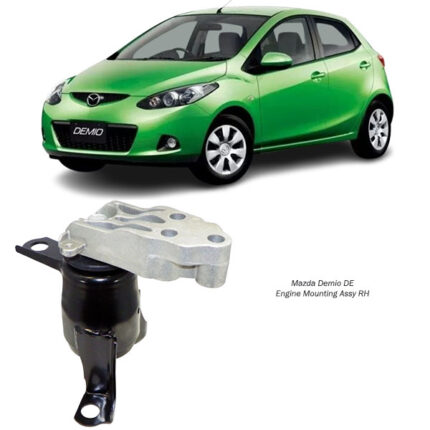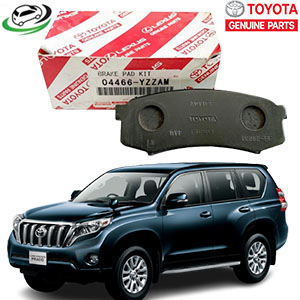-8%
Get Nissan Serena NC25 Front Subframe Crossmember Bushing 54466-JD000 in Kenya
The Front Subframe Crossmember Bushing is a key component within the structure of a vehicle’s suspension and chassis system. It serves as the critical link between the front subframe (also known as the front crossmember) and the vehicle body. Though small and often overlooked, this bushing plays a significant role in maintaining ride comfort, structural alignment, and overall handling stability. It helps isolate road shocks and vibrations, reduce noise, and maintain precise geometry between the chassis and suspension assembly.
1. Purpose and Function
The Front Subframe Crossmember Bushing performs several vital tasks that contribute to the smooth operation and longevity of a vehicle. These include:
-
Vibration Dampening: It absorbs vibrations and impacts that would otherwise be transferred from the road surface to the vehicle’s body, thereby enhancing comfort and reducing wear on other suspension parts.
-
Noise Reduction: It minimizes the amount of road noise transmitted to the cabin, especially when driving on rough or uneven terrain.
-
Structural Cushioning: It allows the subframe some controlled movement under load while still keeping it securely anchored to the vehicle body.
-
Load Distribution: It helps evenly spread mechanical loads and stresses that arise during acceleration, braking, and cornering.
-
Maintaining Suspension Geometry: It preserves alignment and positioning of the subframe relative to the chassis, ensuring the suspension system performs correctly and predictably.
Without the front subframe crossmember bushing, direct metal-to-metal contact between the frame and subframe would lead to excessive noise, harshness, and eventual structural damage.
2. Construction and Materials
This bushing is engineered to endure a harsh environment and high levels of stress. Its construction generally consists of:
-
Rubber or Elastomeric Core: This portion absorbs vibration and isolates movement. Natural rubber is often used for its elasticity and vibration-dampening qualities, although synthetic materials like polyurethane may be chosen for more performance-oriented applications.
-
Outer and Inner Sleeves: Typically made of metal (steel or aluminum), these sleeves allow the bushing to be securely pressed into the subframe and accept mounting bolts or spacers.
-
Bonded Construction: In most cases, the rubber is bonded between the inner and outer metal sleeves, forming a single, unified component capable of absorbing torsional and axial loads.
Some bushings feature hollow sections or voids to permit more flex in specific directions, enhancing comfort while retaining structural integrity.
3. Location and Installation
The front subframe crossmember bushing is installed at the connection points where the front subframe (crossmember) attaches to the vehicle’s main frame or unibody chassis. The subframe supports critical components such as:
-
Front suspension arms
-
Engine mounts
-
Steering rack
-
Stabilizer bar
The bushing typically sits in a recessed housing in the subframe, held in place by a bolt passing through the chassis mount point. Depending on the vehicle design, there may be two, four, or more bushings holding the subframe in place.
Installation of these bushings often requires specialized tools, such as a hydraulic press, especially when replacing them without removing the entire subframe.
4. Importance to Vehicle Dynamics
Though compact, the Front Subframe Crossmember Bushing greatly affects multiple performance aspects:
-
Ride Comfort: Absorbs and isolates harsh impacts from road irregularities, contributing to a smooth ride.
-
Steering Precision: Maintains the exact position of the front subframe, which anchors the steering rack—ensuring sharp, predictable steering.
-
Suspension Alignment: By holding the subframe in position, it prevents shifting that could alter the geometry of suspension arms or affect camber and caster angles.
-
Braking Stability: Prevents subframe flexing under heavy braking, which can help avoid instability or wheel misalignment during deceleration.
-
Noise, Vibration, and Harshness (NVH) Control: Plays a key role in reducing the unwanted vibrations and noises entering the cabin.
5. Signs of Wear or Failure
Over time, front subframe crossmember bushings are subject to fatigue, wear, and degradation due to heat, environmental exposure, and mechanical stress. Signs of worn or failing bushings include:
-
Clunking or Banging Sounds: Most noticeable during acceleration, braking, or driving over bumps.
-
Vibrations: Excessive vibration through the steering wheel or floorboard, especially at idle or low speeds.
-
Wandering Steering: A loose or vague steering feel, often due to subframe misalignment caused by deteriorated bushings.
-
Misalignment: Uneven tire wear or off-center steering wheel may indicate a shift in the subframe position.
-
Visual Deterioration: Cracks, splits, or signs of dry rot in the rubber portion upon visual inspection.
Neglecting to replace worn bushings can result in more severe suspension and steering issues, and in extreme cases, structural damage to the mounting points.
6. Replacement Considerations
When replacing a Front Subframe Crossmember Bushing, several factors should be taken into account:
-
OEM vs Aftermarket: Original bushings maintain factory ride quality and handling characteristics. Aftermarket options, especially polyurethane variants, may offer improved durability or performance but can also increase ride harshness.
-
Installation Method: Some bushings require pressing in and out with specialized tools; others come with brackets or pre-assembled kits for easier installation.
-
Full Set Replacement: Replacing all the subframe bushings at once ensures uniform response and alignment. Replacing just one may cause uneven movement or stress on the remaining bushings.
-
Wheel Alignment: It’s essential to perform a professional alignment after replacing bushings to ensure the suspension angles are restored.
-
Torque Specifications: All bolts must be tightened to the manufacturer’s torque specs, usually with the vehicle’s weight on the suspension to avoid pre-loading the bushings.
7. Types and Variations
There are several types of subframe bushings tailored to different vehicle platforms and usage types:
-
Solid Rubber Bushings: Most common in passenger vehicles, offering a balance of comfort and durability.
-
Hydraulic Bushings: Filled with fluid to further reduce vibration, often found in luxury or higher-end vehicles.
-
Polyurethane Bushings: Stiffer and more durable, suitable for off-road or performance use. Less compliant, leading to a firmer ride.
-
Adjustable Bushings: Rare, but used in motorsports or customized applications to fine-tune subframe position or stiffness.
8. Engineering and Durability
Automotive engineers design subframe bushings to last through thousands of cycles of compression, torsion, and heat exposure. Some key durability considerations include:
-
Tensile Strength: Must endure the vertical loads from the engine and suspension without cracking or deforming.
-
Shear Resistance: Required to withstand the twisting forces during turns and cornering.
-
Temperature Resilience: Should perform reliably under engine bay temperatures ranging from sub-zero to over 100°C.
-
Chemical Resistance: Must resist degradation from oil, grease, water, and road salts.
Testing and simulation of these bushings involve repeated load cycles, heat aging, and chemical exposure to verify real-world durability.
9. Maintenance Tips
While bushings are generally considered non-serviceable, drivers and technicians can take certain steps to ensure longevity:
-
Regular Inspection: Check bushings during oil changes, tire rotations, or suspension checks.
-
Avoid Harsh Driving: Reduce aggressive braking and cornering which put additional stress on bushings.
-
Keep Components Clean: Remove oil or fluid leaks promptly, as they can deteriorate rubber.
-
Address Symptoms Early: Resolving early signs of failure can prevent damage to more costly components like the subframe or control arms.
Follow us on Facebook for more parts.




